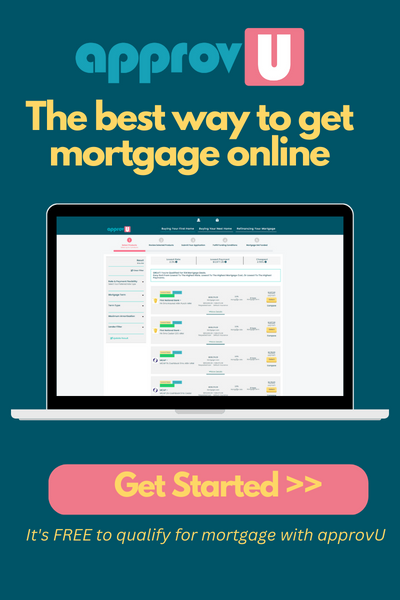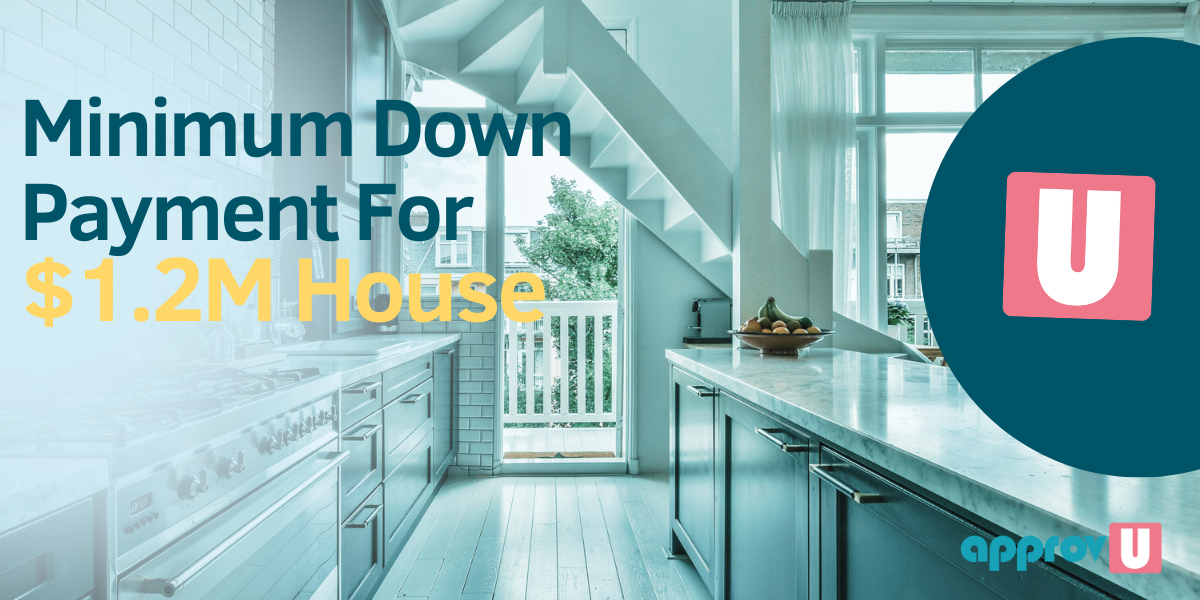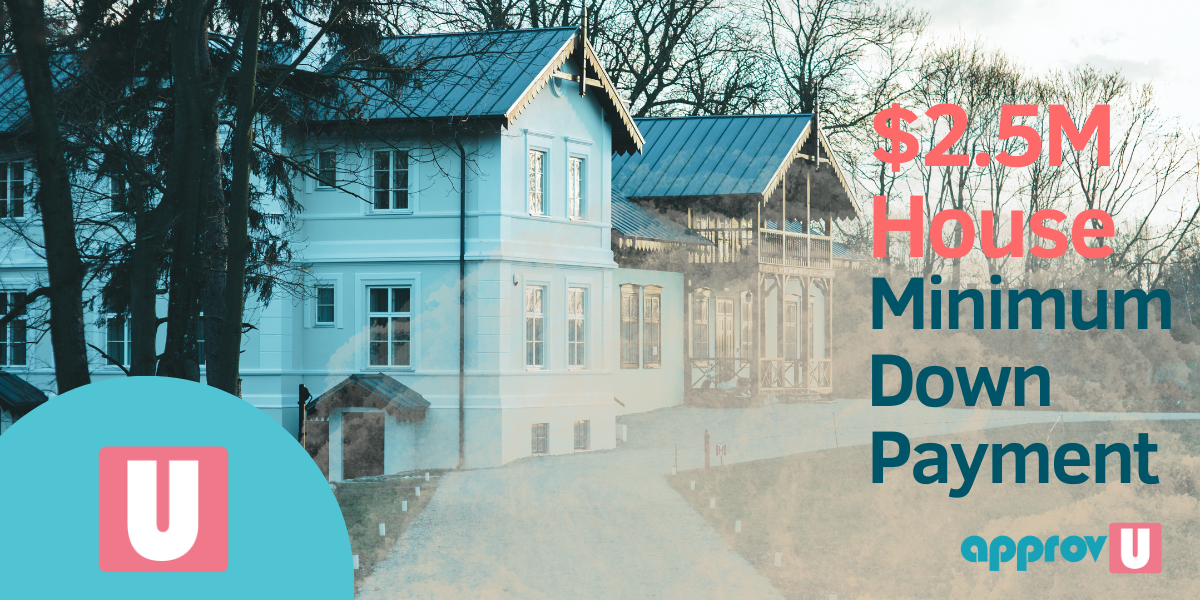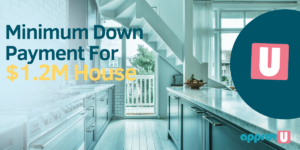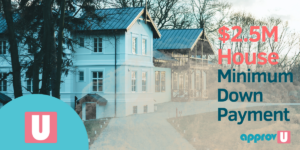Understanding the differences between high-ratio and conventional mortgages is essential to making the right choice.
As an individual seeking a mortgage, you must make an informed decision that aligns with your financial goals and circumstances.
This article will outline the key factors to consider when choosing between these options.
Firstly, let’s clarify the terms.
A high-ratio mortgage refers to a loan where the down payment is less than 20% of the property’s purchase price.
On the other hand, a conventional mortgage is a loan where the down payment is at least 20% of the purchase price.
Understanding the nuances between these two mortgage types is crucial to ensure you select the best suits your needs.
Understanding High-ratio Mortgages
Now that you understand the importance of choosing the right mortgage let’s delve deeper into high-ratio mortgages.
This section will provide valuable insights into high-ratio mortgages’ characteristics, requirements, benefits, and considerations.
A high-ratio mortgage is a type of loan where the down payment is less than 20% of the property’s purchase price.
This means you would need to borrow a larger portion of the purchase price, resulting in a higher loan-to-value ratio.
High-ratio mortgages are commonly sought by first-time homebuyers or those with limited funds for a down payment.
To be eligible for a high-ratio mortgage, you must meet specific requirements.
One of the key requirements is obtaining mortgage default insurance, which protects the lender in case of default.
This insurance adds an additional cost to your mortgage but allows you to secure financing with a smaller down payment.
Pros of High-Ratio Mortgages:
- Quick Entry into Housing Market: High-ratio mortgages provide an opportunity to enter the housing market with limited savings. Traditional mortgages require a substantial down payment of at least 20% of the house price. On the other hand, high-ratio mortgages allow you to purchase a home with a down payment as low as 5% of the home’s value. This lower entry barrier can be especially beneficial for first-time homebuyers who may not have had sufficient time to save a large down payment.
- More Money for Other Needs: By opting for a high-ratio mortgage, you can retain a larger portion of your savings or other liquid assets. This flexibility in using your savings can be advantageous for various purposes, such as covering day-to-day expenses, investing in other opportunities, or maintaining an emergency fund. Rather than tying up a significant amount of funds in a down payment, you can allocate your money where it’s needed most.
- Flexible Payments: High-ratio mortgages often come with various payment options that can make managing your finances more convenient. These options might include the ability to choose between fixed and variable interest rates, the choice of a longer loan term, or even the possibility of making accelerated payments. This flexibility allows you to tailor your mortgage payments to your financial situation, making it easier to budget and adapt to changes in your income or expenses.
- Default Insurance Protection: High-ratio mortgages include default insurance to protect the lender if you cannot make the required payments. This additional protection reduces the risk of default, enabling the lender to provide you with more favourable mortgage rates and terms when compared to a conventional mortgage type.
Cons of High-Ratio Mortgages:
- Default Insurance Costs: One of the significant drawbacks of high-ratio mortgages is the cost of mortgage default insurance. This insurance is required when you have a down payment of less than 20% of the home’s purchase price. The cost of this insurance is typically added to your mortgage amount and paid off over the life of the loan. While mortgage insurance enables you to buy a home with a smaller down payment, it increases the overall cost of the mortgage.
- Higher Monthly Payments: Borrowing a larger portion of the home’s value through a high-ratio mortgage results in higher monthly mortgage payments. With a smaller down payment, you’re taking on a larger loan amount, which means your principal and interest payments will also be larger. The mortgage insurance premium added to your loan also contributes to higher monthly payments. These elevated payments can impact your monthly budget and might require you to allocate more of your income toward housing costs.
- Limited Mortgage Options: In most cases, high-ratio mortgages cannot be used for buying rental properties, accessing mortgages with limited documentation commonly used by self-employed borrowers, or obtaining mortgages designed for individuals with bad credit. These mortgage programs typically require a minimum down payment of 20%.
Exploring Conventional Mortgages
With the insights into high-ratio mortgages, let’s focus on conventional mortgages.
This section will give you a deeper understanding of conventional mortgages’ key features, requirements, benefits, and considerations.
A conventional mortgage is a type of loan where the down payment is at least 20% of the property’s purchase price. Unlike high-ratio mortgages, conventional mortgages do not require mortgage default insurance.
This means you have a higher equity stake in the property, resulting in a lower loan-to-value ratio.
To qualify for a conventional mortgage, you must meet certain requirements, including a sufficient down payment and a stable financial situation.
Lenders typically assess your creditworthiness, income stability, and debt-to-income ratio to determine your eligibility for a conventional mortgage.
Advantages of Conventional Mortgages:
- Elimination of Mortgage Default Insurance: Conventional mortgages do not require default insurance. This absence of insurance premiums translates into considerable cost savings over the life of the mortgage. With the elimination of this extra expense, you have the opportunity to put more money towards reducing your principal balance.
- Better Interest Rates and Loan Terms: The larger down payment for a conventional mortgage helps to demonstrate your financial stability and commitment to the mortgage, which are favourable factors in getting a mortgage. For these positive factors, lenders could offer you more competitive interest rates and improved loan terms. All these translate to a lower monthly payment and potentially substantial savings on interest payments over the life of the loan.
- Flexibility in Loan Limits: Conventional mortgages provide flexibility in the loan limits. With a larger down payment, you hold a higher equity stake in the property. This increased equity can make lenders more willing to approve larger loan amounts. Consequently, you can consider properties with higher price points, expanding your options in the real estate market.
- Suitability for Various Property Types: Conventional mortgages are well-suited for a range of property types beyond primary residences. Whether you’re interested in investing in rental properties or acquiring non-owner-occupied homes, conventional mortgages are generally more widely accepted. This flexibility allows you to diversify your real estate portfolio and explore various investment opportunities.
Disadvantages of Conventional Mortgages:
- Higher Down Payment Requirement: Conventional mortgages typically require a higher down payment, usually around 20% of the property’s purchase price. This can be a substantial upfront cost and might delay your ability to enter the housing market, especially for first-time homebuyers with little savings.
- Potentially Slower Homeownership Entry: Due to the need for a larger down payment, some potential homebuyers might have to save for a more extended period before they can afford to purchase a home, delaying their entry into homeownership.
- Impact of Property Value Fluctuations: With a larger down payment, you have a significant equity stake in the property. However, this also means you are more exposed to fluctuations in property values, which can impact your overall investment.
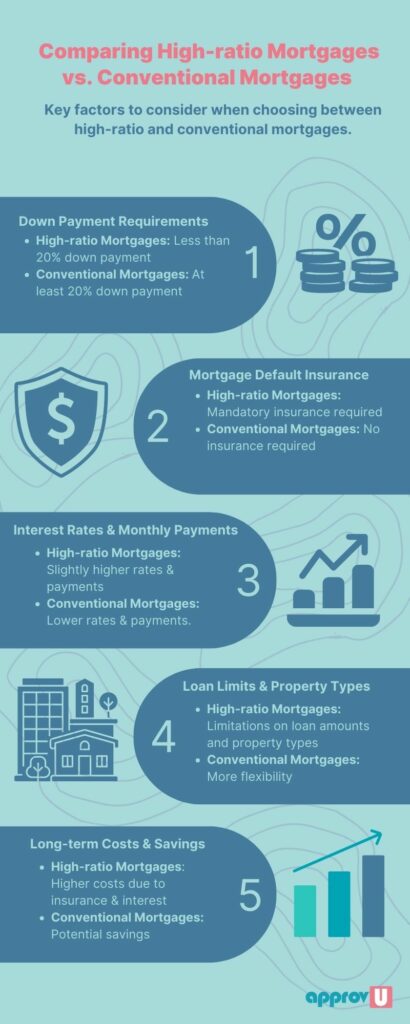
Factors to Consider When Choosing Between High-ratio and Conventional Mortgages
As you weigh your decision between a high-ratio mortgage and a conventional mortgage, several factors should play a role in your choice.
Considering these factors, you can make a well-informed decision aligning with your financial goals and circumstances.
Here are some key factors for you to consider:
Assess Your Financial Situation and Affordability: Look closely at your current financial position, including your income, savings, and monthly expenses. Determine how much you can comfortably allocate towards a down payment and mortgage payments. Make sure that the mortgage you choose aligns with your long-term financial goals.
Evaluate Your Future Goals and Plans: Consider your upcoming plans, whether that involves career advancement, starting a family, or the possibility of relocating. Consider how your mortgage choice might influence your ability to reach these goals. Also, ponder the flexibility you might need in your mortgage terms, such as options for portability or prepayment.
Assess Your Risk Tolerance and Stability: Evaluate how comfortable you are with potential changes in interest rates or property values. Take a moment to reflect on your financial stability and how you manage any fluctuations in your monthly payments. Factor in how mortgage default insurance might impact your overall borrowing costs and financial stability.
Stay Informed About Market Conditions and Mortgage Options: Stay updated on the current conditions and trends in the real estate market. Explore the variety of mortgage options different lenders offer and understand their terms. Research the prevailing interest rate environment and consider how it could affect your mortgage decision.
Seek Professional Advice and Guidance: Don’t hesitate to contact mortgage professionals, like mortgage brokers, agents or specialists. Consult with these experts to evaluate your financial situation and receive personalized advice. Utilize their expertise to navigate the intricacies of mortgages and ultimately make an informed decision.
Conclusion
Choosing between a high-ratio mortgage and a conventional mortgage requires careful consideration of several factors.
By evaluating your financial situation, future goals, risk tolerance, and market conditions and seeking professional advice, you can make an informed decision that suits your needs and sets you on a path toward long-term financial success.



